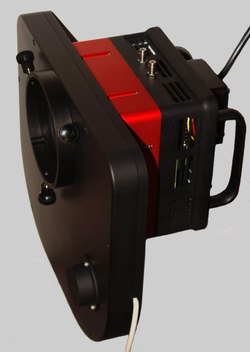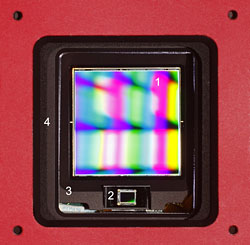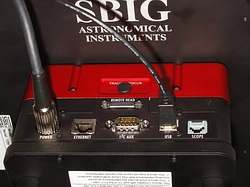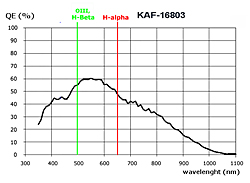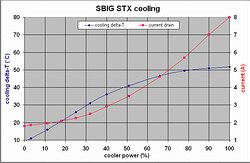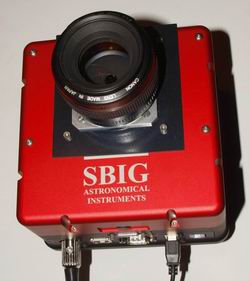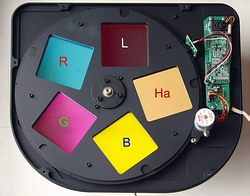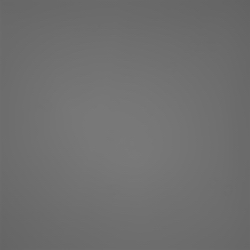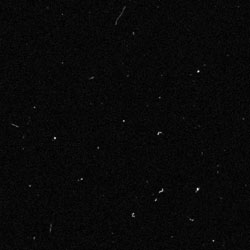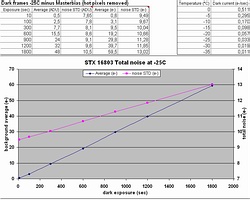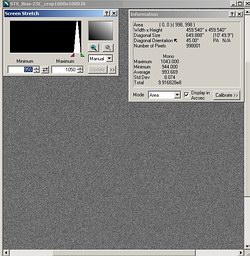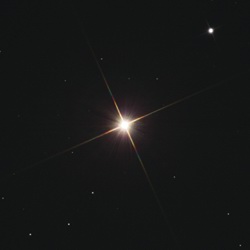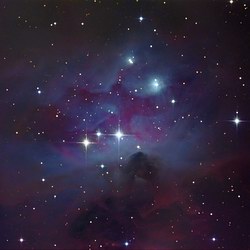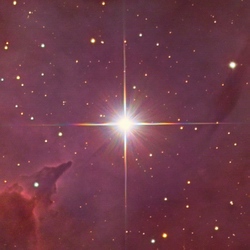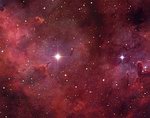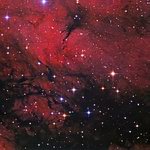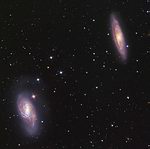Impressions on the SBIG STX-16803
Updated: Nov 10, 2010
|
The camera packed in a
solid pelican case is a very fine machined piece in anodized dark red and
black. The size of the camera is
similar to the STL series, but no filter wheel is included within the body
and it is heavier (2.2 kg). The STX filter wheel adds another 2.4 kg with
filters installed, so the camera-filter wheel combo is at The mechanical shutter
operates between 3600 and 0.1 sec, no electronic shutter is possible for full
frame CCD chips in opposite to the STL-11000. At the connections side (USB, LAN, AUX, autoguider, remote guider, supply) behind the black cap there is the adjustment screw of the focus position for the guide chip available. (track focus) |
|
|
The STX-16803 uses a 37 x
37 mm full frame antiblooming chip with microlenses. The quantum efficiency
peaks at 550 nm with 60% and drops off to 46% at 656 nm (H-alpha). |
|
|
The power consumption of
the camera is acceptable low without active cooling: approx. 1.8 A, peaking
at 2.0 A during the STX filter wheel change. |
|
|
The down side from the
increased distance between chip and chamber window is the big backfocus
distance of 35 mm for the camera itself, the wheel adds another optical 29 mm for a total 64
mm from the flange of the STX filter wheel to the chip. Therefore the use of
Canon or Nikon lenses is not possible when using any filter wheel. |
|
|
The original STX filter
wheel accepts 5 square 65x65mm filters that are held down by a thin baffle
plate that should be tightened just gently. The wheel connects to the camera
AUX connector with a 9 pin plug. |
Light test with the STX-16803/STX wheel/Baader filters
A 1000x1000 cropped 30 min dark
frame at -25C setpoint in full resolution as zipped fits file you find:
here (953 kB)
|
Flat field frame Vignetting is not an issue
with the generous size of the filter wheel housing 65x65 mm square filters. |
|
|
Background evaluation To evaluate the background
for long exposures a 30 min dark frame at -25C is examined. A 100% size jpg
version can be seen to the right. Numerous cosmics are hitting the chip in
random pattern, so it is very essential to do careful data reject procedures
(i.e. sigma reject) on mimimum 3 raw images per channel to eliminate these
artefacts. |
|
|
Dark noise evaluation To check the
characteristics of the dark noise development over time a series dark
exposures have been taken, each of them master bias subtracted, the analyzed
in Maxim. |
|
|
Bias frames A cropped bias frame at
-25C is shown at right with the statistics of the whole frame. |
|
|
Baader LRGB filters To produce 65x65 mm
filters in high quality can be a challenge. The Baader LRGB filter design and
characteristics you can see here. |
|
|
Same target at 60 sec
exposure for the Baader L filter accordingly. The stretched result can be
seen to the right side. |
|
|
My first deep sky test
shot at stormy conditions with this camera targeted at NGC 1977 at f/10 with
the 16": |
|
|
A real life deep sky
example is showing a crop on the bright foreground star SAO 10956 at mag 5.6
exposed at an exposure of 4h for RGB and 4h for H-alpha. |
|
Conclusion Pro |
Deep Sky references with the STX-16803 / Baader Filters
|
|
h and Chi Persei Double Cluster (NGC 869/884)
|
|
|
Details in the Butterfly nebula (IC1318)
|
|
Galaxy Pair in Leo (M 65, M66)
|
